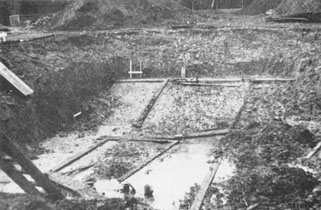Building a Swimming Pool (continued)
Concrete and steel
The two most important immediate requirements were clearly concrete and reinforcing steel. A firm from the neighbourhood contracted to deliver ready-mix concrete to the site in loads of 7 (cubic) yards at a time, at a cost of 67/- per yard. Reinforcing steel was obviously going to be expensive, and a search was made for suitable "scrap" metal; but true scrap was found to be unobtainable except in small quantities of bent and short lengths which would take a long time to accumulate and then to process. A happier solution soon presented itself: an old pupil and present parent of the School, working in an engineering firm, discovered an associated firm that would be willing to supply "deformed" bars, or "seconds", of a quarter inch, three-eighths inch, half inch and three quarter inch diameter, at the special price of £30 a ton delivered, as against the normal price of £46 a ton for reinforcing bars. Since over 33,000 ft. of steel would be needed, this represented a most useful saving. The bars would be in random lengths, the deformations being mainly lines or "ribs'" of a nature which prevented sale at full "round bar" prices, but they would be entirely satisfactory for our purpose.
Some 4,000 separate rods, of different diameters and of 44 different lengths between 2 ft. and 20 ft., had to be cut and bent accurately to the shape needed for construction.
A major item in the construction budget was going to be the "form work" or shuttering for holding the concrete. It could be built of wood, on the spot, at an enormous expense of money and labour; but by a piece of great good fortune, money, labour and perhaps another whole year's work by the School were saved when the project came to the notice of an old pupil who was Overseas Manager in the firm of Wimpey's. Wimpey's not only lent the necessary equipment, consisting of more than 19,000 separate parts and worth about £750, for as long as the School might need it: they sent careful instructions about its use, and took a genuine personal interest in the progress of the work. This was much the largest single benefaction among the many that were made, as well as one of the most heartening.

|
A morass of mud, April 1962.
|


